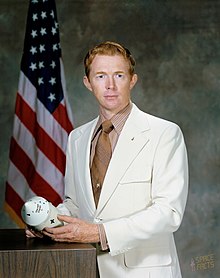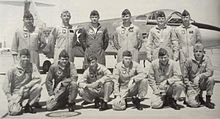Stuart Roosa
Stuart Roosa | |
|---|---|
 Roosa in 1971 | |
| Born | Stuart Allen Roosa August 16, 1933 Durango, Colorado, U.S. |
| Died | December 12, 1994 (aged 61) Falls Church, Virginia, U.S. |
| Resting place | Arlington National Cemetery |
| Education | Oklahoma State University, Stillwater University of Arizona University of Colorado, Boulder (BS) |
| Awards | NASA Distinguished Service Medal |
| Space career | |
| NASA astronaut | |
| Rank | Colonel, USAF |
Time in space | 9d 0h 1m |
| Selection | NASA Group 5 (1966) |
| Missions | Apollo 14 |
Mission insignia | |
| Retirement | February 1, 1976 |
| Signature | |
Stuart Allen Roosa (August 16, 1933 – December 12, 1994) was an American aeronautical engineer, smokejumper, United States Air Force pilot, test pilot, and NASA astronaut, who was the Command Module Pilot for the Apollo 14 mission. The mission lasted from January 31 to February 9, 1971, and was the third mission to land astronauts (Alan Shepard and Edgar Mitchell) on the Moon. While Shepard and Mitchell spent two days on the lunar surface, Roosa conducted experiments from orbit in the Command Module Kitty Hawk. He was one of 24 men to travel to the Moon, which he orbited 34 times.[1]
Biography
[edit]Early life and education
[edit]Roosa was born on August 16, 1933, in Durango, Colorado, to parents Dewey Roosa (1903–1988) and Lorine Roosa (née DeLozier; 1908–1993) and grew up in Claremore, Oklahoma. He attended Justus Grade School and Claremore High School in Claremore, Oklahoma, from which he graduated in 1951. Thereafter, he studied at Oklahoma State University and the University of Arizona,[2] before graduating with a Bachelor of Science degree in aeronautical engineering with honors from the University of Colorado Boulder in 1960.[3]
Military service
[edit]
Roosa began his career as a smokejumper with the U.S. Forest Service, dropping into at least four active fires in Oregon and California during the 1953 fire season. He was a graduate of the Aviation Cadet Program at Williams Air Force Base, Arizona, where he received his flight training commission in the U.S. Air Force. He also attended the U.S. Air Force Aerospace Research Pilot School (Class 64C) and was an experimental test pilot at Edwards Air Force Base in California before being selected for the astronaut class of 1966.[3]
From July 1962 to August 1964, Roosa was a maintenance flight test pilot at Olmstead Air Force Base, Pennsylvania, flying F-101 Voodoo aircraft.[4] He was a fighter pilot at Langley Air Force Base, Virginia, where he flew the F-84F Thunderstreak and F-100 Super Sabre aircraft. Following graduation from the University of Colorado, under the U.S. Air Force Institute of Technology Program, he served as Chief of Service Engineering (AFLC) at Tachikawa Air Base, Japan, for two years.[5]
NASA career
[edit]
Roosa was one of 19 people selected as part of the astronaut class of 1966.[6] He was the Capsule communicator (CAPCOM) at the Launch Complex 34 blockhouse during the Apollo 1 fire on January 27, 1967.[7] In 1969, he served as a member of the astronaut support crew for the Apollo 9 mission.[3]
On Apollo 14, he spent 33 hours in solo orbit around the Moon, conducting an extensive series of experiments. As part of a joint U.S. Forest Service/NASA project, he carried seeds from loblolly pine, sycamore, sweet gum, redwood, and Douglas fir trees. The seeds were germinated on his return and planted throughout the United States, becoming known as the "Moon Trees".[8]
Roosa later served as backup Command Module Pilot for Apollo 16 and Apollo 17. Based on crew rotations, he would probably have commanded one of the last missions had they not been cancelled. He was assigned to the Space Shuttle program until his retirement as a colonel from the Air Force in 1976.[3]
Roosa logged 5,500 hours of flying time; 5,000 hours in jet aircraft. He also logged 217 hours in space.[3]
Post-NASA career
[edit]Roosa, who attended Harvard Business School's six-week Advanced Management Program in 1973,[2] later held a number of positions in international and U.S. businesses.[9] He founded Gulf Coast Coors in 1981; he served as its president until his death.[9]
Death
[edit]
On December 12, 1994, Roosa died at age 61 in Washington, D.C., from complications of pancreatitis.[3] He was survived by his wife Joan, three sons and a daughter, and seven grandchildren.[3]
Roosa is buried in Arlington National Cemetery.[10][11] His wife Joan died on October 30, 2007, in Gulfport, Mississippi. She was interred at Arlington with her husband.[12]
Organizations
[edit]Roosa's memberships include the Society of Experimental Test Pilots, New York Safari Club, Board of Directors, People-to-People Sports Committee, Hunting Hall of Fame, Circumnavigators Club, Explorers Club, Commemorative Air Force, Shikar-Safari-Club and Gulfport Yacht Club.[3]
Awards and honors
[edit]Roosa's honors include the NASA Distinguished Service Medal; the MSC Superior Achievement Award (1970); the Air Force Command Pilot Astronaut Wings; the Air Force Distinguished Service Medal; the Arnold Air Society's John F. Kennedy Award (1971); the City of New York Gold Medal (1971); the American Astronautical Society's Flight Achievement Award (1971); the Order of Tehad (1973); and the Order of the Central African Empire (1973). Additionally, an elementary school in Claremore, Oklahoma is named in his honor. He received an honorary LL.D. from University of St. Thomas, Houston in 1971.
He was one of five Oklahoman astronauts inducted into the Oklahoma Aviation and Space Hall of Fame in 1980[13] and he was inducted into the International Space Hall of Fame in 1983.[14][15] Roosa was posthumously inducted into the U.S. Astronaut Hall of Fame in 1997.[16][17]
In media
[edit]- In the HBO miniseries From the Earth to the Moon (1998), Roosa was played by George Newbern.[18]
- The book Smoke Jumper, Moon Pilot (2011), by Willie G. Moseley, is a biography on Roosa's life.[19]
- In 2013, footage of Roosa's son holding a photo of Roosa with two of his granddaughters[20] appears in USAA insurance television ads promoting availability to family members.
See also
[edit]References
[edit]- ^ NASA Apollo 14 page
- ^ a b "STUART ALLEN ROOSA (COLONEL, USAF, RET.), NASA ASTRONAUT (DECEASED)" (PDF). Biographical Data (Press release). Johnson Space Center, Houston: NASA. December 1994. Archived (PDF) from the original on April 2, 2019. Retrieved January 8, 2021.
- ^ a b c d e f g h Steitz, David E.; Herring, Kyle (December 12, 1994). "Press release 94-210: Apollo Astronaut Stuart Allen Roosa Dies". NASA Public Affairs (Press release). Washington, DC: NASA. Archived from the original on May 2, 1999. Retrieved December 23, 2013.
- ^ "Piloted the command module on Apollo 14 mission". New Mexico Museum of Space History. Retrieved November 12, 2017.
- ^ "Roosa's flight experience". Nssdc.gsfc.nasa.gov. Retrieved August 11, 2017.
- ^ Thompson, Ronald (April 5, 1966). "19 New Spacemen Are Named". The High Point Enterprise. High Point, North Carolina. p. 2A – via Newspapers.com.
- ^ Shayler, David (2002). Apollo: The Lost and Forgotten Missions. Springer Science & Business Media. p. 131. ISBN 978-1852335755.
- ^ "Houston, We Have Moon Trees". Peeling Back the Bark. Forest History Society. February 17, 2011.
- ^ a b Dispatch Staff (December 24, 1994). "Mississippian Stuart Roosa set his goals in the stars and achieved them well". Clarion–Ledger. Jackson, Mississippi: Gannet. The Commercial Dispatch. p. 10. Retrieved August 16, 2023 – via Newspapers.com.
- ^ Burial Detail: Roosa, Stuart A (section 7A, grave 73) – ANC Explorer
- ^ "Stuart A. Roosa". New Mexico Museum of Space History. Retrieved January 2, 2021.
- ^ Colin Burgess, ed. (2010). Footprints in the dust : the epic voyages of Apollo, 1969–1975. University of Nebraska Press. p. 195. ISBN 978-0803226654.
- ^ "State Aviation Hall of Fame Inducts 9". The Daily Oklahoman. Oklahoma City, Oklahoma. December 19, 1980. p. 2S – via Newspapers.com.
- ^ "Stuart A. Roosa". New Mexico Museum of Space History. Retrieved January 2, 2021.
- ^ Sheppard, David (October 2, 1983). "Space Hall Inducts 14 Apollo Program Astronauts". El Paso Times. El Paso, Texas. p. 18 – via Newspapers.com.
- ^ "Stuart A. Roosa - Astronaut Scholarship Foundation". astronautscholarship.org. Retrieved August 11, 2017.
- ^ Meyer, Marilyn (October 2, 1997). "Ceremony to Honor Astronauts". Florida Today. Cocoa, Florida. p. 2B – via Newspapers.com.
- ^ Credits, From the Earth to the Moon (1998 miniseries)
- ^ Moseley, Willie G. (2011). Smoke Jumper, Moon Pilot. Acclaim Press. ISBN 978-1935001768.
- ^ "USAA TV Spot, 'Earned'". iSpot TV.
External links
[edit]- Astronautix biography of Stuart Roosa
- Stuart Roosa at IMDb
- Roosa at Encyclopedia of Science
- Joan Barrett Roosa Obituary
- "Houston, We Have Moon Trees". Peeling Back the Bark blog, the Forest History Society.
- Stuart Roosa
- 1933 births
- 1994 deaths
- 1971 in spaceflight
- Apollo 14
- Air Force Institute of Technology alumni
- Aviators from Colorado
- Apollo program astronauts
- American aerospace engineers
- Burials at Arlington National Cemetery
- American business executives
- Deaths from pancreatitis
- Oklahoma State University alumni
- People from Claremore, Oklahoma
- People from Durango, Colorado
- Recipients of the Air Force Distinguished Service Medal
- Recipients of the NASA Distinguished Service Medal
- United States Air Force officers
- United States Astronaut Hall of Fame inductees
- University of Arizona alumni
- University of Colorado alumni
- U.S. Air Force Test Pilot School alumni
- United States Air Force astronauts
- 20th-century American businesspeople
- 20th-century American engineers
